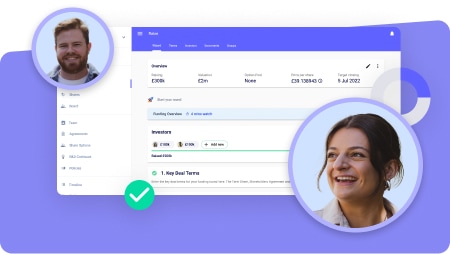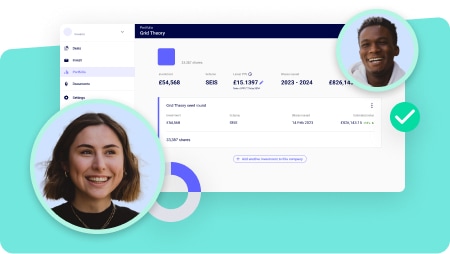Read transcript
Anthony Rose: Every day I meet amazing founders on SeedLegals and I love helping them share their story. So let me introduce you to Hamish from Mapify Logistics. Hamish, tell me what Mapify does.
Hamish Geddes: So at Mapify, we work with the large logistics companies, places like ports, railways, warehouses, haulage companies. And we take all of these really ancient IT systems from the 90s that are spitting out data around maintenance or compliance or… accepting work orders and those kinds of things. They spit them out in Excel, they don’t talk to each other and they drop specialists in the deep end with spreadsheets and macros that they have to deal with to make those decisions fast. Ultimately it takes them loads of hours. We bring that down to minutes.
Anthony Rose: Okay, so you’ve got Network Rail as a customer. They’ve got a few assets. Tell me how you help them manage their assets.
Hamish Geddes: Yeah, so I’ll give you an actual example of one of the ones that we solved first with them. So we took their seasonal delivery trains, so these are the guys that go around cleaning leaves on the line, removing all of the problems that ultimately affect friction and safety of that line, but also performance. So we, in the early days, saw that they were taking all of this data from an ancient IT system, trying to compare that with incident data from another IT system, along with the weather data that was coming from the Met Office, and they’re trying to understand which areas of the line really need to be treated and which ones can we ignore when we’ve missed maintenance or there’s an issue there but it’s just a one-off and those kind of things and they would just be spending hours on hours just going through each one you know some people would know a little more some people know a little less but depending on how long they’ve been in the job but ultimately it’s a really manual manual job so no one really stays in it very long so the retention problem and analysis problem and these people didn’t have the skills to go through a spreadsheet and make it far quicker.
Anthony Rose: Okay, so Mapify Logistics, is it integrating lots of legacy systems or is it just a new thing that replaces a lot of legacy systems?
Hamish Geddes: So that’s the clever bit that we do, that’s how we apply AI within our business, is we go through, when we’re onboarding a customer like Network Rail or someone in ports like Ports of Leith or Port of Tyne, these guys have IT systems that were put in in the 90s, they all work differently, the APIs don’t have very good documentation and I think in the past, previously, people have had to headbang their way through these organisations to get this data out. That’s kind of how we do help leverage partly the organisation itself to mobilise and onboard and aggregate these systems. But we have some clever algorithms in the background to help us get that data out and ultimately mine it so that we can start to use it with these new AI companies.
Anthony Rose: Okay, so give us the elevator pitch if you’re a company that does X, this is a problem we’re to solve with Mapify.
Hamish Geddes: Yeah, so if you’re a company that is, you know, spending multiple hours every day with one specialist, two specialists, and they’re ultimately affecting the bottom line. So maintenance costs, anything like revenue uptake, are we making the most of the vehicles and the assets we have, potentially even hitting fines from things like people overworking or vehicles not being in check and compliance checks. We take all of that data and bring it into one place so it’s not disparate, it’s not speaking to each other, so that those failures that end up causing a huge bottleneck in the organisation don’t happen.
Anthony Rose: Okay, and how many people are in the business?
Hamish Geddes: So we’ve got currently eight people, part fractional, part full-time. We’ve iterated loads over the past year, so it’s been very useful to have that cadence between the developer team and kind of commercial team that’s out there full-time trying to get the product in. But we’re now actually bringing more people full-time in as well.
Anthony Rose: Okay, nice. And you’ve got an interesting background. Tell us about Hyperloop.
Hamish Geddes: Yeah, so Hyperloop is where I personally started my career and also how this company came about. So back in 2016 we used to build those high speed train pods so they were effectively miniature vehicles that sat in a vacuum tube, went up to high speed. And we took them to SpaceX facilities in LA, three years running so we’d get that feedback from some guys that are now working on these rockets today and then come back with iterated designs the next year. But by the time we got to the end of that project, we realised that actually there was already low-hanging fruit within, and huge opportunity within logistics as a whole. We didn’t need to invent a whole new system. And that’s kind of what one day I ended up in exactly that call, looking at these leaves on the line specialists. They never see anybody like a random outsider come into these meetings. But I just watched them, and I realised this is where we can find the efficiencies and the improvement in logistics worldwide.
Anthony Rose: So you pivoted from a business which would be a sink of enormous amounts of money, which you could only afford if you’re the world’s richest person, into something that is a SaaS business that makes money immediately.
Hamish Geddes: Pretty much, yeah. So we realised early on that there was a core problem there that we could solve with one user group. And as we started to explore other user groups within just the same organisation, we realised they had the same spreadsheet problem. And then we started to converge on actually logistics as a whole has the same problem of mapping stuff and aggregating it into the same place. What, your things are moving from A to B? There’s codependency from everything, we’ve all used these tools like JIRA and Confluence and how they help us project manage: well, effectively, these people are doing that internally, but none of their tools are pulled into the same place.
Anthony Rose: All right, so get up for network rail.
Hamish Geddes: Yeah yeah, yeah, if we wanted to, yeah.
Anthony Rose: Amazing. Okay, great. So how can people get in touch with you to learn more?
Hamish Geddes: Well, you can search mapifylogistics.com, look up Mapify Logistics on LinkedIn, search myself, Hamish Geddes, or my co-founder, Selby Carey. And you’ll also see that we’re promoting our podcast right now, Ship Happens, where we’re just sharing all of the horror stories and logistics every day and a little bit of what’s going on up in Scotland right now with some of the startups, not just logistics-based, that are popping off. So find us and get in touch anytime.
Anthony Rose: All right, and you’d never guess by the accent, but you’re based in Edinburgh.
Hamish Geddes: I’m based in Edinburgh from Glasgow, but we’re also down in London all the time and over in the US and often as well. So any time you want to catch a coffee in any of those places, just let me know.
Anthony Rose: All right. Thanks, Hamish. That was fantastic and looking forward to my next train trip with Network Rail being more efficient and safer as a result.
Hamish Geddes: And hopefully up to Edinburgh to come see us.
Anthony Rose: All right. Thank you.
Hamish Geddes: See you soon.
From ports to railways to haulage companies, much of the logistics industry still relies on outdated systems. This traps specialists in a digital maze of clunky spreadsheets and manual data entry – making every maintenance, compliance and asset decision a very time-consuming puzzle to solve.
But fear not! Mapify Logistics rose to the challenge, with its application of AI to transform complex, disconnected data into real-time actionable insights. Hamish Geddes, Founder and CEO, is here to reduce hours of work to mere minutes, helping companies to optimise operations, cut costs and improve efficiency by eliminating slow manual processes.
Catch up with Anthony Rose, CEO and Co-Founder of SeedLegals, as he discusses Hamish’s background in Hyperloop engineering as well as the ways that Mapify is now supporting Network Rail and other major players to modernise their infrastructure..
Key takeaways
The problem with inefficient logistics
- Major logistics companies are using disparate IT systems that don’t communicate with each other.
- Specialists are forced to manually piece together data across Excel and other software, wasting valuable hours on tasks that should only take minutes.
- Lacking integrated insights means that maintenance is delayed and there are more compliance risks, which ultimately affects the company’s functionality and profitability.
Mapify’s solution
- Mapify Logistics aggregates and automates data so that informed decisions can be made quickly and without the involvement of spreadsheet overloading.
- The platform targets legacy systems and optimises asset management for organisations like Network Rail.
- By implementing AI, Mapify can reduce costly inefficiencies.
Traction and growth
- Currently an eight-person team, Mapify is on the road to rapid expansion as they hire a greater number of full-time members to scale operations.
- Its SaaS model allows businesses to see immediate ROI, making it an economical solution for scaling logistics companies.
- Early clients like Network Rail have witnessed significant improvements in data accessibility.
SeedLegals events
Connect with fascinating founders
Sign up to our newsletter and get the best of SeedLegals events delivered directly to your inbox.



















